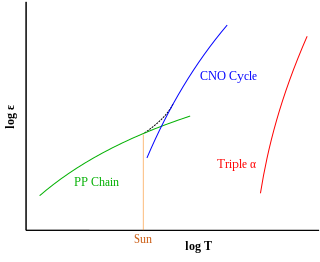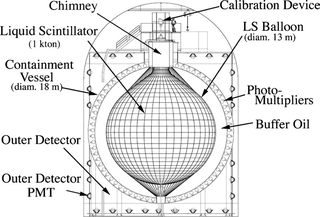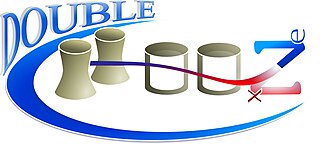
The neutron is a subatomic particle, symbol
n
or
n0
, which has a neutral charge, and a mass slightly greater than that of a proton. Protons and neutrons constitute the nuclei of atoms. Since protons and neutrons behave similarly within the nucleus, they are both referred to as nucleons. Nucleons have a mass of approximately one atomic mass unit, or dalton, symbol Da. Their properties and interactions are described by nuclear physics. Protons and neutrons are not elementary particles; each is composed of three quarks.

In nuclear physics, the island of stability is a predicted set of isotopes of superheavy elements that may have considerably longer half-lives than known isotopes of these elements. It is predicted to appear as an "island" in the chart of nuclides, separated from known stable and long-lived primordial radionuclides. Its theoretical existence is attributed to stabilizing effects of predicted "magic numbers" of protons and neutrons in the superheavy mass region.

Stellar nucleosynthesis is the creation (nucleosynthesis) of chemical elements by nuclear fusion reactions within stars. Stellar nucleosynthesis has occurred since the original creation of hydrogen, helium and lithium during the Big Bang. As a predictive theory, it yields accurate estimates of the observed abundances of the elements. It explains why the observed abundances of elements change over time and why some elements and their isotopes are much more abundant than others. The theory was initially proposed by Fred Hoyle in 1946, who later refined it in 1954. Further advances were made, especially to nucleosynthesis by neutron capture of the elements heavier than iron, by Margaret and Geoffrey Burbidge, William Alfred Fowler and Fred Hoyle in their famous 1957 B2FH paper, which became one of the most heavily cited papers in astrophysics history.

Samuel Chao Chung Ting is an American physicist who, with Burton Richter, received the Nobel Prize in 1976 for discovering the subatomic J/ψ particle.
An axion is a hypothetical elementary particle originally postulated by the Peccei–Quinn theory in 1977 to resolve the strong CP problem in quantum chromodynamics (QCD). If axions exist and have low mass within a specific range, they are of interest as a possible component of cold dark matter.

In nuclear astrophysics, the rapid neutron-capture process, also known as the r-process, is a set of nuclear reactions that is responsible for the creation of approximately half of the atomic nuclei heavier than iron, the "heavy elements", with the other half produced by the p-process and s-process. The r-process usually synthesizes the most neutron-rich stable isotopes of each heavy element. The r-process can typically synthesize the heaviest four isotopes of every heavy element; of these, the heavier two are called r-only nuclei because they are created exclusively via the r-process. Abundance peaks for the r-process occur near mass numbers A = 82, A = 130 and A = 196.

A natural nuclear fission reactor is a uranium deposit where self-sustaining nuclear chain reactions occur. The conditions under which a natural nuclear reactor could exist were predicted in 1956 by Paul Kuroda. The remnants of an extinct or fossil nuclear fission reactor, where self-sustaining nuclear reactions have occurred in the past, are verified by analysis of isotope ratios of uranium and of the fission products. This was first discovered in 1972 in Oklo, Gabon by Francis Perrin under conditions very similar to Kuroda's predictions.

The Kamioka Liquid Scintillator Antineutrino Detector (KamLAND) is an electron antineutrino detector at the Kamioka Observatory, an underground neutrino detection facility in Hida, Gifu, Japan. The device is situated in a drift mine shaft in the old KamiokaNDE cavity in the Japanese Alps. The site is surrounded by 53 Japanese commercial nuclear reactors. Nuclear reactors produce electron antineutrinos () during the decay of radioactive fission products in the nuclear fuel. Like the intensity of light from a light bulb or a distant star, the isotropically-emitted flux decreases at 1/R2 per increasing distance R from the reactor. The device is sensitive up to an estimated 25% of antineutrinos from nuclear reactors that exceed the threshold energy of 1.8 megaelectronvolts (MeV) and thus produces a signal in the detector.
Uranium (92U) is a naturally occurring radioactive element that has no stable isotope. It has two primordial isotopes, uranium-238 and uranium-235, that have long half-lives and are found in appreciable quantity in the Earth's crust. The decay product uranium-234 is also found. Other isotopes such as uranium-233 have been produced in breeder reactors. In addition to isotopes found in nature or nuclear reactors, many isotopes with far shorter half-lives have been produced, ranging from 214U to 242U. The standard atomic weight of natural uranium is 238.02891(3).
Naturally occurring xenon (54Xe) consists of seven stable isotopes and two very long-lived isotopes. Double electron capture has been observed in 124Xe and double beta decay in 136Xe, which are among the longest measured half-lives of all nuclides. The isotopes 126Xe and 134Xe are also predicted to undergo double beta decay, but this has never been observed in these isotopes, so they are considered to be stable. Beyond these stable forms, 32 artificial unstable isotopes and various isomers have been studied, the longest-lived of which is 127Xe with a half-life of 36.345 days. All other isotopes have half-lives less than 12 days, most less than 20 hours. The shortest-lived isotope, 108Xe, has a half-life of 58 μs, and is the heaviest known nuclide with equal numbers of protons and neutrons. Of known isomers, the longest-lived is 131mXe with a half-life of 11.934 days. 129Xe is produced by beta decay of 129I ; 131mXe, 133Xe, 133mXe, and 135Xe are some of the fission products of both 235U and 239Pu, so are used as indicators of nuclear explosions.
Inverse beta decay, commonly abbreviated to IBD, is a nuclear reaction involving an electron antineutrino scattering off a proton, creating a positron and a neutron. This process is commonly used in the detection of electron antineutrinos in neutrino detectors, such as the first detection of antineutrinos in the Cowan–Reines neutrino experiment, or in neutrino experiments such as KamLAND and Borexino. It is an essential process to experiments involving low-energy neutrinos such as those studying neutrino oscillation, reactor neutrinos, sterile neutrinos, and geoneutrinos.

The Daya Bay Reactor Neutrino Experiment is a China-based multinational particle physics project studying neutrinos, in particular neutrino oscillations. The multinational collaboration includes researchers from China, Chile, the United States, Taiwan, Russia, and the Czech Republic. The US side of the project is funded by the US Department of Energy's Office of High Energy Physics.

Main Injector Experiment for ν-A, or MINERνA, is a neutrino scattering experiment which uses the NuMI beamline at Fermilab. MINERνA seeks to measure low energy neutrino interactions both in support of neutrino oscillation experiments and also to study the strong dynamics of the nucleon and nucleus that affect these interactions.
In particle physics, hexaquarks, alternatively known as sexaquarks, are a large family of hypothetical particles, each particle consisting of six quarks or antiquarks of any flavours. Six constituent quarks in any of several combinations could yield a colour charge of zero; for example a hexaquark might contain either six quarks, resembling two baryons bound together, or three quarks and three antiquarks. Once formed, dibaryons are predicted to be fairly stable by the standards of particle physics.

Ultracold neutrons (UCN) are free neutrons which can be stored in traps made from certain materials. The storage is based on the reflection of UCN by such materials under any angle of incidence.

The nuclear drip line is the boundary beyond which atomic nuclei are unbound with respect to the emission of a proton or neutron.

Double Chooz was a short-baseline neutrino oscillation experiment in Chooz, France. Its goal was to measure or set a limit on the θ13 mixing angle, a neutrino oscillation parameter responsible for changing electron neutrinos into other neutrinos. The experiment uses reactors of the Chooz Nuclear Power Plant as a neutrino source and measures the flux of neutrinos they receive. To accomplish this, Double Chooz has a set of two detectors situated 400 meters and 1050 meters from the reactors. Double Chooz was a successor to the Chooz experiment; one of its detectors occupies the same site as its predecessor. Until January 2015 all data has been collected using only the far detector. The near detector was completed in September 2014, after construction delays, and started taking data at the beginning of 2015. Both detectors stopped taking data in late December 2017.
The STEREO experiment investigates the possible oscillation of neutrinos from a nuclear reactor into light so-called sterile neutrinos. It is located at the Institut Laue–Langevin (ILL) in Grenoble, France. The experiment started operating and taking data in November 2016.
Blayne Ryan Heckel is an American experimental physicist, known for his research involving precision measurements in atomic physics and gravitational physics. He is now a professor emeritus at the University of Washington in Seattle.
George Michael Fuller is an American theoretical physicist, known for his research on nuclear astrophysics involving weak interactions, neutrino flavor-mixing, and quark matter, as well as the hypothetical nuclear matter.














